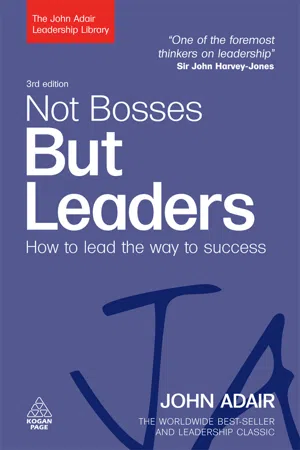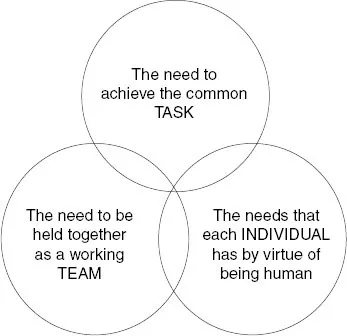![]() PART 1
PART 1![]()
Qualities of Leadership
‘Tell me about leadership,’ began the young manager. ‘What actually is it? I have recently read two books on the subject and I am none the wiser.’
‘Forget about the books,’ I replied. ‘Look back upon your own experience. You have been both a leader and led by others. What do you think makes a person a leader?’
The young manager looked out of the window and thought for a few minutes. ‘I suppose that it’s the ability to influence others to achieve a common goal.’
‘That’s not a bad definition, but what constitutes this uncommon ability you have just identified? Why does one person emerge as the leader in a group rather than another?’
The young manager had some ideas about that. He mentioned several qualities that he felt were significant, such as courage and perseverance. He stressed the importance of knowledge. After listening to him I suggested that it might be interesting for us both to look at the research relating to the subject of leadership.
‘Not that it will tell you much that is new,’ I added, ‘but it may help you to put into better order what you know already – so that you can make more use of it in your own career as a manager, and – perhaps – to develop leadership in others more effectively.’
‘That seems like a good idea. Where do we begin?’
‘As the King of Hearts in Alice in Wonderland said, let’s begin at the beginning and go on until we come to the end, and then stop. Consider first the most widespread assumption about leaders, namely that leaders possess certain qualities that will make them leaders in any circumstances, such as initiative, determination, patience, and so on. Not long after research into leadership had got underway some 40 years ago, some researchers had the idea of looking at the various lists of leadership qualities that were beginning to appear in the studies. They found that there was apparently little or no agreement on what the qualities of a leader are.
‘When I was Adviser in Leadership Training at the Royal Military Academy, Sandhurst, for example, I reviewed all the lists of leadership qualities being taught in schools for young officer cadets throughout the Western world – the Royal Air Force, the Royal Navy, France, Germany, the US Army and the US Marine Corps among them. The only quality that appeared on all the lists was courage.’
‘But surely that doesn’t help much,’ interjected the young manager. ‘I imagine that all soldiers need the quality of physical courage, not just the officers.’
‘I agree. Physical courage is really a military virtue, not a specific leadership quality. That leads us to the second drawback of the qualities approach, as I call it.’
‘What’s that?’
‘Even if a list of leadership qualities could be identified, the qualities approach does not form the best starting point for leadership training. It is often associated with the view that leaders are born and not made. You may have heard the story of the business executive who read in his annual report “Smith is not a born leader yet.” What do you suggest he should do about it?’
The young manager laughed. ‘I see what you mean,’ he said. ‘But does that mean the qualities idea has nothing more to offer? I noticed that a few moments ago you said there was only an apparent lack of agreement about leadership qualities. What did you mean?’
‘Well, I believe that we do know some things about the qualities of leaders. In the first instance, leaders should possess and exemplify the qualities expected or required in that particular working group. Physical courage, for example, may not make you into a military leader, but you cannot be one without it. You could apply the same principle to all working groups – engineers, accountants, academics, nurses, ministers, politicians…’
‘And managers?’
‘Of course,’ I replied. ‘If you want to be leader of managers – a managing director or chief executive – you should personify the qualities that are expected or required in all managers. We should have to return to the question of what they might be. But leadership is more than possessing the qualities that are required and respected in your walk of life. There are certain qualities that are the hallmarks of good leaders. Let me write down some headings on the flip chart:
| Integrity | Integrity has been defined as the quality that makes people trust you. And trust is of central importance in all personal relationships. Integrity means literally personal wholeness. It also conveys the sense of adherence to standards or values outside yourself – especially the truth. Trust and truth are first cousins. |
| Enthusiasm | I cannot think of any leaders I know who lack enthusiasm, can you? It seems to be a general characteristic of leaders. |
| Warmth | A ‘cold fish’ does not usually make a good leader. A warm personality is infectious. |
| Calmness | An important characteristic, recognized long ago by the Roman historian Tacitus when he wrote: ‘Reason and calm judgement, the qualities especially belonging to a leader.’ |
| Tough but fair | The combination of toughness – or demanding ness – and fairness has emerged in industry during the past 10 years as a desirable quality. |
‘From the last point you can see that it’s the juxtaposition of qualities – that pattern of qualities – that matters most. Just as oxygen combined with hydrogen is somewhat different from oxygen when it links up with carbon, so – for example – a sense of humour takes on a different nature if allied to one set of qualities rather than another.’
‘And so it’s still worth thinking about qualities. But can you develop them. How about a sense of humour?’ suggested the young manager.
‘Yes, all leadership qualities can be developed – some more than others – by practice and experience. Part of that process, which takes place over a lifetime, is contemplating the qualities of other leaders.
‘Each new leader you meet, or perhaps an attribute that you have never quite seen before. It’s like contemplating the different facets of a diamond. However, valuable though it is – especially in the longer term – the qualities approach is not the best starting point for leadership development. Research changed direction.’
![]()
Situational Leadership
‘A second main approach to the study of leadership has emphasized the importance of the situation in determining who should become – and remain – the leader of a group. For, according to the early situationalists, there is no such thing as a born leader; it all depends on the situation. Put a person in one situation and he or she may emerge as a leader; put him or her in another one and he or she will not. Churchill was undoubtedly a great leader in wartime, but was he so successful in peace?
‘In fact in the very year in which Churchill became Prime Minister – 1940 – an American professor called W O Jenkins made a study of leadership and concluded with a classic definition of the situational approach:
Leadership is specific to the particular situation under investigation. Who becomes the leader of a particular group engaging in a particular activity and what the leadership characteristics are in the given case are a function of the specific situation… There are wide variations in the characteristics of individuals who become leaders in similar situations and even greater divergence in leadership behaviour in different situations… The only common factor appears to be that leaders in a particular field need and tend to possess superior general or technical competence or knowledge in that area. General intelligence does not seem to be the answer.
‘Note that point about “superior general or technical competence or knowledge” in the particular field. There are perhaps three kinds of authority in leadership. There is the authority of position or rank, the authority of knowledge, and the authority of personality. The situational approach emphasizes that second kind of authority. As one manager put it:
Authority flows from the one who knows
‘Hold on!’ exclaimed the young manager. ‘Hold on!’ He began to tell me about people who had plenty of professional or technical qualifications – engineers, accountants and draughtsmen – who had worked in his company for many years. ‘But no one – I repeat no one,’ he said, ‘regarded them as leaders. That theory must be wrong!’
‘What do you mean?’ I asked.
‘Surely there is a more general leadership ability?’ He thought for a moment and then added: ‘I suppose that is what the “leadership qualities” people were seeking.’
‘Yes,’ I replied. ‘The situational approach also seemed to lend some weight to the idea that you need not have an appointed or elected leader in a group – just let the situation decide who should be the leader! That sounded more democratic than leadership vested in one person.’
‘You mean that they wanted to abolish leaders. Leadership becomes a sort of cake to be shared or a football to be passed from one player to another?’ asked the young manager incredulously.
‘You’re right,’ I answered, ‘but perhaps we should not go into the way that culture and climate has influenced research into leadership at this point. As an alternative to what may seem like democratic turn-taking in leadership responsibility, we can now see that what works better is a flexibility on the part of the designated leader. Initially people may require and welcome a considerable degree of direction. Later they may simply need coaching or support. When the team is performing really well and clearly achieving its task, people may prefer to be allowed to get on with it without interference. If they encounter problems it may, once again, be appropriate for the leader to offer support or even perhaps direction if superior knowledge or experience of similar situations is helpful and the advice is therefore effective.’
![]()
Functional Leadership
‘There are three ingredients or variables when people are working together: the leader himself or herself – personality and character – the situation in which it’s all happening, and the group, the followers or subordinates,’ I continued.
‘The next approach to leadership stemmed from studies on the third ingredient – the group. All working groups are different from each other. Providing it has been together for some time a working group develops a group personality, as a British Prime Minister writing about Cabinets called it. Because of this factor, within the same organization what works in one group may not work in another. In this respect groups resemble individual persons, for we are all unique individuals with our own distinctive personalities, characters and appearances. But, you and I have needs in common – we shall both be tired at midnight and hungry at breakfast time. In the same way, working groups also share certain needs in common. There are three main areas of need present in working groups:
‘I have seen your three rings somewhere before,’ reflected the young manager. ‘But to be quite frank I have never quite understood them. I can see that a working group has a task to do, but why do you introduce this word need. That sounds like a bit of jargon to me.’
‘Yes, I suppose that “task need” is a jargon phrase. But it is useful. It describes an important perception about groups, namely that there is a collective energy within them to accomplish what they are there to do. “The lust to finish”, as John Wesley once called it.’
‘An...






